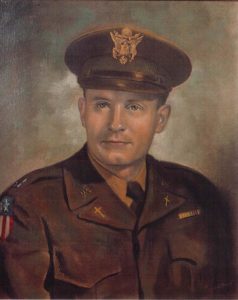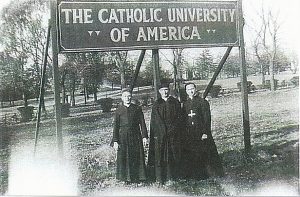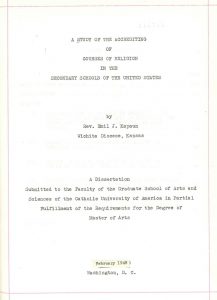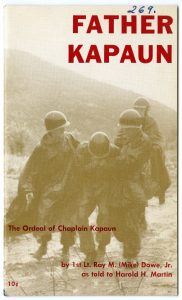Father Emil Kapaun, a military chaplain who died tragically as a prisoner of war in Korea in 1950, was known as “a shepherd in combat boots,” a perplexing phrase at first blush. How does one reconcile the image of the humble shepherd with that of a soldier in combat boots? Father Kapaun, who was declared a Servant of God in 1993 by Pope John Paul II, embodies both the fighter and the shepherd.

Born on April 20, 1916 to German and Bohemian Catholic parents just outside of Pilsen, Kansas, young Emil grew up laboring on the 160-acre farm where his family raised cows, chickens, pigs, and grew wheat and corn. Summers on the Kansas plains were sweltering hot, and winters, bitterly cold. Serving as an altar boy at Pilsen’s St. John Nepomucene Church, young Emil was influenced in his Catholic faith by the church’s pastor, Father John Sklenar. Witnessing the fervency of his faith as a boy, Father Sklenar, along with his parents, Bessie and Enos Kapaun, apparently marked Kapaun as a priest from a young age. Though young Emil began high school and college at Conception Abbey in northwest Missouri when he was 14, he returned home in the summers to work the fields with his father, brother, and members of the Pilsen farming community. His concentration on his studies was intense, and he did so well in his classes that he was known by his schoolmates as “the Brain.”[1]

After completing his training at Kenrick Seminary in St. Louis, Missouri in 1940, Kapaun was ordained a diocesan priest and assigned to the parish in which he’d grown up. But he had a taste for studying military and political affairs in Europe and elsewhere, writing to his brother Eugene about conflict in Europe throughout his time in the seminary. After the Japanese attack on Pearl Harbor, he witnessed men his own age leaving Pilsen for service and notified his Wichita diocese bishop, Christian Herman Winkelmann, that he felt called to work as a military chaplain. The bishop refused, however, instructing him to remain as Assistant to Father Sklenar at St. John Nepomucene. He followed the events of the war, writing about them in his diary, noting the call for chaplains. He began volunteering part time at the military airfield at nearby Herington, Kansas, and wrote letters to local soldiers. His letters, sermons, and talks to soldiers interwove faith and military service. To one group, his biographer William Maher notes, he preached, “…a Catholic soldier will have his heart set on obedience and faithfulness to duty to service of his country and through that service, to the honor and glory of God.”[2]
Father Kapaun remained at the parish where he had grown up, but he didn’t feel comfortable replacing the priest who had been there more than 50 years, and to whose ways the parishioners had become accustomed. He again petitioned Bishop Winkelmann:
When I was ordained, I was determined to ‘spend myself’ for God. I was determined to do that cheerfully, no matter in what circumstances I would be placed or how hard a life I would be asked to lead. That is why I volunteered for the army and that is why today I would a thousand times rather be working deprived of all ordinary comforts, being a true ‘Father’ to all my people, than by living in a nice comfortable place with with my conscience telling me that I am an obstacle to many.[3]
Bishop Winkelmann finally agreed to allow Father Kapaun to train for a military chaplaincy. Kapaun began his military career in August, 1944 in a class of 145 chaplains. In addition to rigorous physical training involving long marches and calisthenics, Kapaun studied chemical warfare and military sanitation. He enjoyed military life, writing to a friend, “They want to toughen us up in a hurry and I really enjoy it.”[4] Among other things, he learned that he had to promote the religious life of everyone in his unit (no matter the faith tradition), travel from outpost to outpost among scattered troops, and comfort the sick and wounded, all of these instructions he put to use not only during World War Two, but in the Korean War as well. He eventually ended up serving in the China-India-Burma theatre of war operations, also traveling to Bermuda, the Azores, Casablanca, Tripoli, and New Delhi, celebrating mass and ministering to soldiers, refugees, and civilians during this time.[5]

After receiving orders to return to the U.S. in April, 1946, Kapaun conferred with his bishop on furthering his education. He began studies at The Catholic University of America in Washington, D.C. in 1946. A master’s degree in education from the University would qualify him to teach at both Catholic and public schools in Kansas.
But alas, the military life still called him. He wrote his bishop in 1948 that “I believe I should offer myself for work in the Armed Forces, especially in this crisis.”[6] The crisis to which he referred was the uptick in tensions between the U.S. and the Soviet Union over land access to West Berlin. The U.S. responded to the Soviet blockage of the city with its “Berlin Airlift” of supplies to the citizens of the former German capital. He reentered military service in 1948, and after a period of service in U.S.-occupied Japan in 1950, he was assigned to duty as chaplain of the 3rd Battalion, 8th Cavalry Regiment early in the Korean War. As chaplain, he ministered to the dead, heard confessions, and celebrated mass using the hood of a jeep as an altar.

Kapaun saved 15 soldiers by dragging them to safety during the Battle of Unsan in November, 1950. He was captured by Chinese soldiers on November 2, 1950, and sent to a prison camp, where he died from illness and malnutrition. For his service and bravery, he was awarded the Medal of Honor by President Barack Obama in 2013 (the 60th anniversary of the end of Korean War). In 1993, Pope John Paul II made Father Kapaun a servant of God, the first stage on the path to canonization.
View the website devoted to Father Kapaun’s Canonization: https://catholicdioceseofwichita.org/father-kapaun/
[1] William L. Maher, A Shepherd in Combat Boots, Chaplain Emil Kapaun of the 1st Cavalry Division (Shippensburg, PA: Burd Street Press, 1997), chapter 1,38.
[2] Maher, A Shepherd in Combat Boots, 45-49.
[3] Maher, A Shepherd in Combat Boots, 54.
[4] Maher, A Shepherd in Combat Boots, 54.
[5] Maher, A Shepherd in Combat Boots, 56.
[6] Maher, A Shepherd in Combat Boots, 68.
